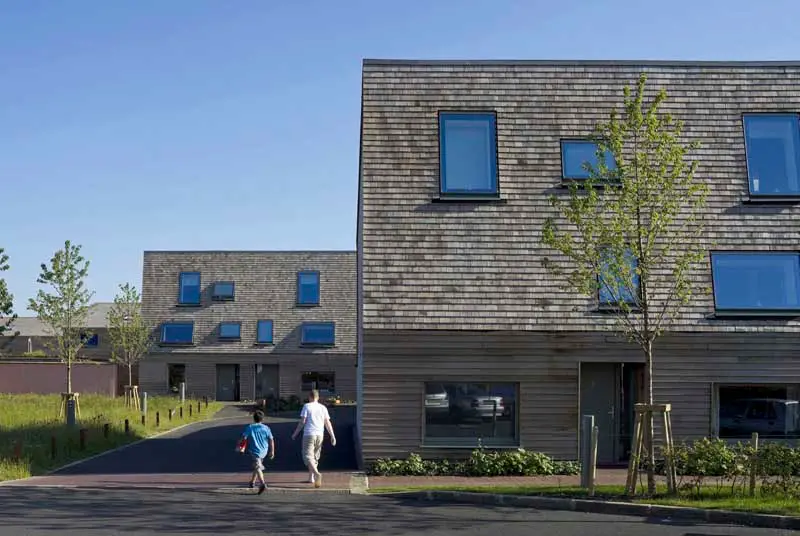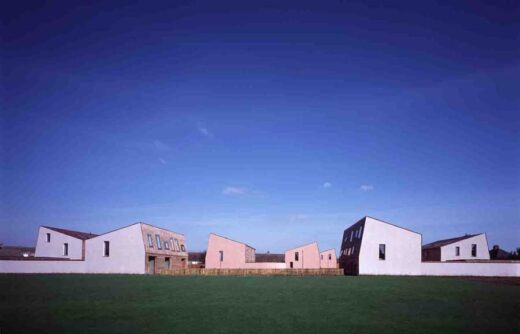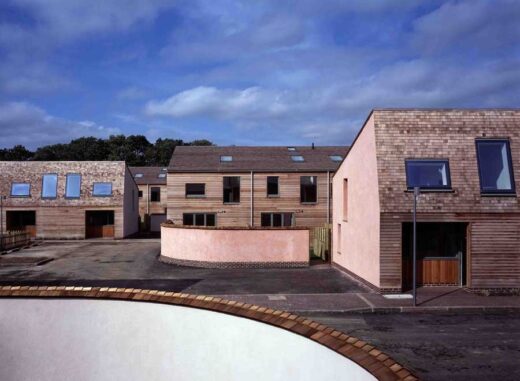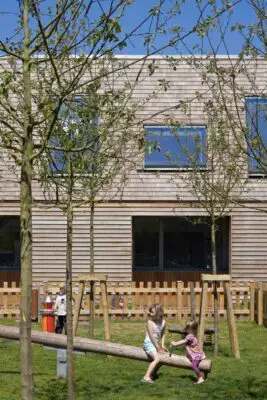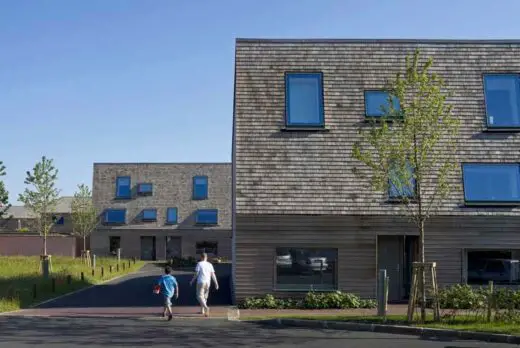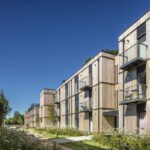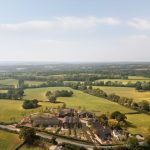Suffolk Housing, Clay Fields Affordable Homes, Architect, House News, Building Design, Flats
Clay Fields Suffolk Housing
Residential Buildings in Elmswell: New Architecture in east England design by Riches Hawley Mikhail Architects, UK
14 Nov 2008
Design: Riches Hawley Mikhail Architects
Clay Fields in Elmswell
Suffolk Affordable Housing
Riches Hawley Mikhail Architects’ new affordable housing scheme, situated within an existing village in Suffolk will be officially opened on Friday 28 November.
Clay Fields consists of 26 affordable homes – nine three-bed houses, 13 two-bed and four one-bed flats for local people. It combines contemporary design, sustainable construction with low energy use and innovative local materials. For example, the project sees the first UK sprayed application of Hemcrete®, a mix of lime and hemp, which captures carbon from the atmosphere – making it a less than zero carbon material. It helps to make the construction airtight by embedding the timber-framed structure in the insulation.
Riches Hawley Mikhail were commissioned in 2006 following a RIBA design competition led by Orwell Housing Association in partnership with Elmswell Parish Council, Mid Suffolk District Council and the Suffolk Preservation Society. The competition was a response to the lack of affordable housing for local people in a rapidly-growing commuter belt. The brief demanded a high quality, low carbon homes without any ‘greenwash’ or highly visible environmental interventions. There are no solar panels or wind turbines extruding from the houses. It is above all, the thoughtful design that gives the project its eco-credentials. This is eco-minimalism.
Riches Hawley Mikhail has designed a terrace consisting of three houses at Clay Fields. These terraces have been carefully positioned in distinctive groups staggered around open space and adjacent to the neighbouring housing. The homes are designed to be low, in keeping with the surrounding buildings to minimise the visual impact and avoid overshadowing. Orientated north-south to maximise the heat of the sun and generate the best possible light, even the low winter sun (typical of the area’s flat landscape) will reach everyone.
The front facades are clad in continuous wooden weatherboards. Variety is brought to the elevations through the different positioning and size of windows, punched out of the wooden cladding. The arrangement of the windows was determined by engineers Buro Happold, who worked out the optimal relationship between solar gain and daylight, as well as making the most of the beautiful views out. All homes get a view – they do not look onto each other but onto open space.
The landscaping was born out of a desire to make a series of enjoyable places for people to look at and use as well as being a vital contribution to village life. The landscaping includes four communal green spaces that can be used by both the residents and the neighbouring community: a low-maintenance wildflower meadow, a Suffolk-apple orchard, allotments with composting facilities and a kick-around area. This mix of landscape treatments and a series of ‘swales’ (dips and hollows like those made by medieval ploughing), provide natural drainage to the site which was previously prone to water-logging.
Internally, the layout is carefully designed to maximise space, light and through-ventilation. The floors are staggered with an open stairwell running from the kitchen to the rooflights allowing a through-flow of air, so the homes are ventilated naturally in the summer. In winter, an additional mechanical system removes 80 per cent of heat from outgoing air and uses it to heat incoming air.
The project features a number of systems that have helped to make it an energy-efficient build and will keep the energy bills low when in use.
Innovations include the use of Isonat – a hemp/ linen insulation material, a biomass community heating system (fuelled by locally sourced wood chips) that heats all the homes from a single boiler and rainwater recycling. Site waste was minimised with the use of Hemcrete®, pre-fabricated timber frames and topsoil has been stored and redistributed across the site.
Residents have been consulted at every stage. The local primary school has been involved in the project from the beginning, with site visits and talks encouraging a real sense of ownership of both the homes and the spaces where the children will play.
Residents will be given a user-friendly guide, “How to live in your eco-home”, containing helpful tips like when to and when not to open windows, to ensure that the green aspirations of the project are continued in practice. Buro Happold will carry out an evaluation of energy consumption, once all the households have moved in.
Stephen Javes, Chief Executive, Orwell Housing Association comments: “We are very proud of this new development at Elmswell, not only because of its sustainable and energy saving features but because it fulfils our major aim of creating affordable homes which are attractive and good to live in and which add value to the local community.”
Opening event, 28 Nov 2008. The event includes a tree planting ceremony, lunch and a technical seminar. Talks by: RHM Architects, Seamans Builders and Buro Happold.
Clay Fields Elmswell – Project Team:
Architect: Riches Hawley Mikhail Architects Client: Orwell Housing Association Landscape Architect: J&L Gibbons LLP M&E: Inviron Structural Engineer: BTA Structural Design Ltd
Sustainability engineer: Buro Happold Ltd. Civil Engineers: Scott Taylor incorporating Cameron Taylor Contractor O. Seaman and Son Ltd.
QS: Hyams and Partners
Funding: East England Development Agency, Housing Corporation
Riches Hawley Mikhail is a young practice established in 2005 by directors Annalie Riches, Cathy Hawley and David Mikhail. As a practice they are committed to a sustainable future and this is illustrated in their understanding of materials and technologies. Other current projects include new housing in Liverpool, London and Manchester.
The new homes have been developed for Orwell Housing Association by e², a consortium of housing associations of which Orwell is the founding member. The aim of e² is to build strong and sustainable communities by providing high quality affordable homes and community facilities in the Eastern Region. e² is providing some 580 new homes across the region at a cost of £58 million in the period 2006-08.”
Suffolk Preservation Society, founded in 1929, originally worked to protect the county’s buildings and landscape. Today, the society has broadened its focus to help shape Suffolk’s future, largely campaigning for sensitive and appropriate development, more and better quality affordable homes and to ensure sustainable infrastructures are in place to support the county’s communities.
Tradical® Hemcrete® is a thermal hemp-lime walling solution. Unique and highly sustainable, it is a blend of hemp shiv and a lime based binder, which together form a bio-composite building material. Hemcrete® can capture significant amounts of carbon from the atmosphere. Hemp, in common with all similar plants, captures CO” and releases oxygen during its rapid growth. At Clay Fields it is anticipated the use of Tradical® Hemcrete® will enable the locking up of around 65 tonnes of carbon dioxide.
Clay Fields Housing Suffolk – information receievd 141108
Riches Hawley Mikhail Architects
Location: Elmswell, Suffolk, England, UK
Suffolk Building Designs
Suffolk Buildings
Wood Farm
Architects: Studio RHE
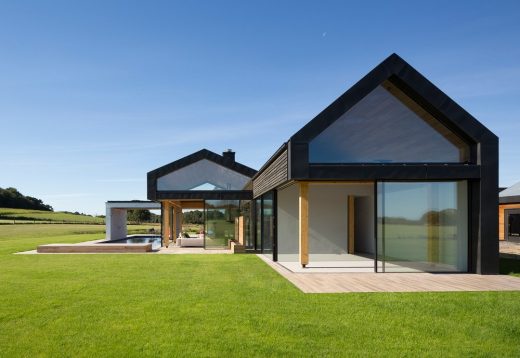
photo : Dirk Lindner
Wood Farm in Suffolk
Balancing Barn, Thorington
Design: MVRDV
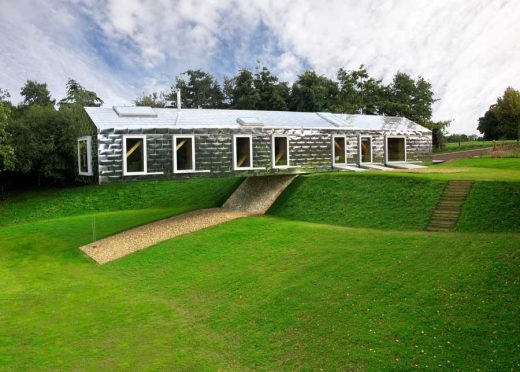
photo : Living Architecture
Balancing Barn Suffolk
Black Barn, off-grid Paragraph 55 country home in Suffolk
Design: Studio Bark
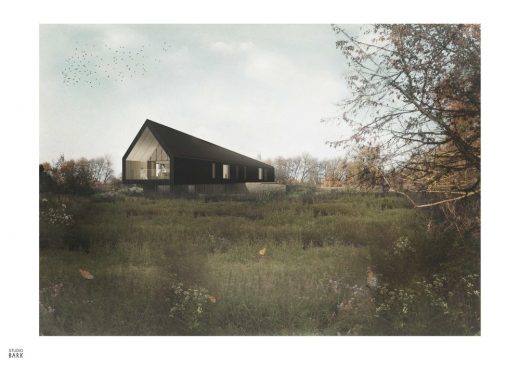
image from architect
Black Barn in Suffolk
English Architecture
Contemporary Architecture in England
English Architecture Design – chronological list
Comments / photos for the Suffolk Residential Architecture design by Riches Hawley Mikhail Architects page welcome

